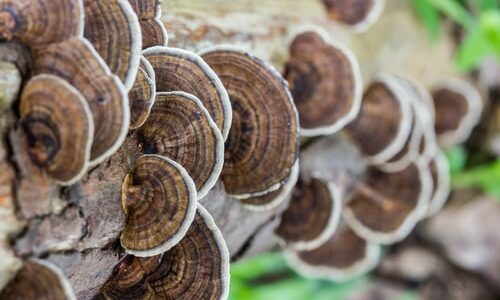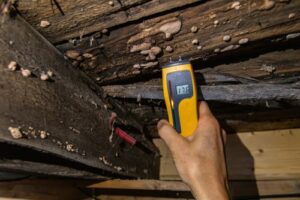
Wood Fungus Treatment and Prevention
What are wood-decaying fungi?

The Three Types
A wood fungus is any variety of fungus that consumes the cellulose in moist wood, causing it to rot. There are a wide variety of fungus on wood. They are best identified by the type of rot that they cause, the most common including soft, white, and brown rot.
Soft rot fungi are heartier than white or brown varieties and can spread more easily in conditions that are too hot, cold, or wet for their counterparts. Soft rot leaves microscopic cavities in wood that can lead to structural damage. They are less aggressive in their decomposition, but more hearty. Like their namesake, telltale softness in wooden structures is a sign of their presence.
White rot fungi causes rotted wood to feel moist and appear whitish-yellow
in coloring. This white coloring comes from crystalline cellulose in the wood. A few examples of white wood rot fungi include the honey mushroom, oyster mushrooms, tinder fungus, and artist’s conk.
Brown rot fungi are similar to white rot in many ways, except that the process leaves behind darker colored decay that cracks, shrinks, and generally warps the wood. Well known brown rot fungi include the mine fungus, cellar fungus, and sulfur shelf. Brown rot can travel through damp drywall or plaster to cause wood decay but it is sometimes referred to as “dry rot” due to its crumbly nature.
Are wood destroying fungi dangerous?
Wood rot from fungi is dangerous because of how quickly it can consume the bones of a building once it comes into contact with them. Fungal growth will destroy the strength of lumber and in turn cause cracks, leaks, and overall structural damage. The moisture that comes with decaying wood is also a big draw for pest animals or insects that can move in, making your single problem into multiple problems. If you notice fungus on rotting wood in your home or business, have a professional evaluate the severity of the problem.
Why do I have a fungus?
Fungus on wood requires four specific things to thrive:
- Oxygen
- Favorable temperatures
- Water
- Food
These requirements are met when the moisture content of wood exceeds 20 to 30 percent and the temperature ranges between 40 and 90 degrees Fahrenheit. Your best bet in determining and preventing the type of wood decaying fungi in your home is to have a professional who is an expert in wood-destroying pests and organisms assess the issue.
Four ways to prevent wood-decaying fungi.
Moisture control is your best preventative against the spread of wood-decaying fungi. Here are four tips for preventing moisture that could lead to fungus wood rot:
- Make sure you only build with treated wood that is less likely to absorb nearby moisture.
- If you notice moisture build-up in any area of your home due to a plumbing leak or crack, call a professional to fix it immediately.
- Keep your gutters and downspouts clear of debris, since water build-up is a common side effect of their lack of cleanliness.
- Grade the outside of your home so that moisture flows away from your foundation and doesn’t soak into basement walls.
How does Gregory Pest provide wood fungus treatment?
Gregory Pest employs experts who are specially trained in house fungus identification and the eradication of wood-destroying pests and organisms. Once you call us to set up an appointment for the removal of wood-decaying fungi, a professional will be sent immediately to identify which variety of fungi has infested your home and then will create an ecologically and environmentally friendly plan to both remove existing fungi and prevent any future infestations from spreading. Your safety is our first concern.
Where can I get help with wood-decaying fungi?
Gregory Pest Solutions in South Carolina is the leading local provider of residential and commercial pest control services. If you discover wood decay issues such as fungus in a crawl space or wood rot anywhere in your home, give us a call.
If you’re having issues with vapor barriers, excessive moisture and dehumidifiers running non-stop in your home, Gregory provides a residential moisture control service to keep your home safe from mold, mildew and the pests that thrive in these environments.
Gregory Pest Solutions can identify the type of mold causing problems in your property. Call today.
